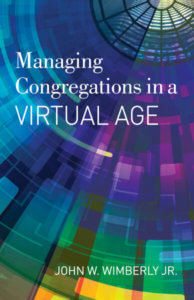Turning toward a hybrid future, churches have focused much attention on digital worship. John Wimberly says it’s just as important to consider how to work with staff and volunteers. He names key issues for managing programs and ministries in an era when working from home and digital meetings are likely to remain part of congregational life.
Congregations do not have a choice about whether to use technology to serve their members and communities. To serve God in the 21st century, mastering technology is mandatory. Yet not everything is going to be different post-pandemic. The core functions and teachings of a religious community will remain the same. Pastoral care, teaching the faith, leading worship, and mission to the community are a few of the ministries that flow from the core functions of a congregation. These core beliefs and practices are not going to change post-pandemic or ever. We need to stay focused on our core functions but be flexible in how we do them.
1. Communication is key.
Communication, important in every type of management, takes on even greater importance virtually than it does when people are working face to face. Numerous clergy struggled with intrateam communications early in the pandemic period. As the pandemic proceeded, they realized the missing component was casual conversations that take place in the office. Non-congregational managers who have been managing virtually for years have developed ways of watching for moments when communication may be less than optimum and calling it to the individual’s or team’s attention. Their favorite strategy was an old-fashioned individual phone call to find out why there was a problem.
2. Accountability is essential.
During the pandemic, numerous congregational managers worried about how they could hold their staff and volunteer teams accountable. As they worried, I think they woke up to a problem that existed before going virtual — namely, too many congregations are essentially accountability-free zones. There is little attempt to hold staff or volunteers accountable for their work. Indeed, in some congregations, what they are supposed to do is not sufficiently defined. A person may be defined as a religious education staffer, for example, but has no quantifiable deliverables.
The transition to virtual management during the pandemic raised the accountability issue to a new level of awareness for managers and congregation members. Worship was an area with increased attention to measurables. I was fascinated that more clergy were talking about “attendance” when worship was virtual than when it was face to face. Certainly, part of this notice was due to the novelty of online worship for some congregations. I would argue that clergy should be just as focused on how many people are attending face-to-face worship services.
As congregations organize themselves in a post-pandemic hybrid model, they need to remain focused on who among their staff teams and volunteers is doing what, when, and how well. This will be especially important in that some long-term older members may be suspicious of staff who start spending large portions of their time working from home. The way one achieves high performance is by holding people accountable for deliverables, which depends on asking the right questions. Do people deliver what they were asked to deliver? Do they deliver it on time? Do they deliver the quality of work product that is expected?
3. Teams work.
During the pandemic period, many clergy expressed a sense of weakening team bonds. One rabbi I interviewed said his team was losing the “shared stories.” Lose the story and we lose the sense of being a people. With renewed face-to-face interaction, the hybrid model should restore what was lost in a strictly virtual time and create new stories in the future.
4. Solitude is useful.
The move to a hybrid model is an excellent opportunity to debunk the mythology that an office is the best place to accomplish work. The shift to increased home-based work during the pandemic gave employers a penetrating look into which tasks can be done well from home and which are better accomplished in person. Eve Edelstein, cofounder of the consulting firm Clinicians for Design, says her research suggests that “individual work has always suffered in the traditional workplace, with its abundant distractions.”
I’m not sure why this insight is not better appreciated. Forever, many clergy have left the office in an attempt to find some peace and quiet. Who can write a sermon with people regularly coming into our office with questions, conversations taking place in the hallway, or the front doorbell ringing? Given the swirl of activity around a pastor’s office, I am not even sure it is the best place for pastoral counseling and other tasks that require total concentration. As we live into the hybrid model, we need to explain the advantages of working from home to our staff and members alike.
5. Offices matter.
It is important to think creatively about church offices. A huge amount of literature says that companies and other organizations will lose their clients and participants if work and gathering spaces are not perceived as healthy. I talked with a clinical therapist who gave up her office during the pandemic because so many of her clients refused to go there. It had no windows that could be opened and an old, poorly maintained HVAC system. These types of health and safety issues are going to impact congregations post-pandemic.
 This article is excerpted from Managing Congregations in a Virtual Age by John W. Wimberly, Jr copyright © 2021 Fortress Press. Used by Permission. The book is available at Fortress Press, Cokesbury, and Amazon.
This article is excerpted from Managing Congregations in a Virtual Age by John W. Wimberly, Jr copyright © 2021 Fortress Press. Used by Permission. The book is available at Fortress Press, Cokesbury, and Amazon.
Related Resources
- Keeping Church Staff Accountable to the Overall Mission by John W. Wimberly, Jr.
- There’s No Going Back to the Pre-Pandemic Church by Kay Kotan
- 10 Ways to Cultivate a Creative Culture by Phil Cooke






